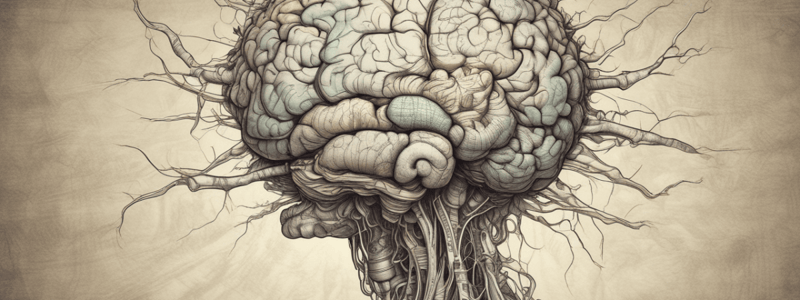Podcast
Questions and Answers
Match the following brain regions with their functions in emotional processing:
Match the following brain regions with their functions in emotional processing:
Amygdala = Processing affective information Inferior Frontal Cortex = Combining sensory information with emotional information Orbitofrontal Cortex = Interpreting context and regulating behavior Temporal Lobe = Processing sensory information
Match the following cognitive processes with their associated brain regions:
Match the following cognitive processes with their associated brain regions:
Autonoetic Awareness = Medial or Ventral Frontal-Lobe Behavioral Self-Regulation = Prefrontal Cortex Contextual Understanding = Orbitofrontal Cortex Default Mode Network = Cingulate Cortex
Match the following brain regions with their effects when damaged:
Match the following brain regions with their effects when damaged:
Orbitofrontal Cortex = Difficulty interpreting context and altering behavior Medial or Ventral Frontal-Lobe = Deficit in autonoetic awareness Prefrontal Cortex = Impaired executive function Cingulate Cortex = Impaired error detection
Match the following cognitive processes with their characteristics:
Match the following cognitive processes with their characteristics:
Match the following brain regions with their functional properties:
Match the following brain regions with their functional properties:
Match the following brain regions with their respective functions:
Match the following brain regions with their respective functions:
Match the following cognitive tasks with their corresponding brain regions:
Match the following cognitive tasks with their corresponding brain regions:
Match the following brain regions with their corresponding functions in the default mode network:
Match the following brain regions with their corresponding functions in the default mode network:
Match the following cognitive deficits with their corresponding brain regions:
Match the following cognitive deficits with their corresponding brain regions:
Match the following brain regions with their connections in the prefrontal cortex function:
Match the following brain regions with their connections in the prefrontal cortex function:
Match the following neuroanatomical regions with their respective functions in emotion processing:
Match the following neuroanatomical regions with their respective functions in emotion processing:
Match the following cognitive tasks with their corresponding cognitive processes:
Match the following cognitive tasks with their corresponding cognitive processes:
Match the following parts of the cingulate cortex with their anatomical locations:
Match the following parts of the cingulate cortex with their anatomical locations:
Match the following brain regions with their roles in emotional processing:
Match the following brain regions with their roles in emotional processing:
Match the following brain regions with their corresponding subregions:
Match the following brain regions with their corresponding subregions:
Match the following deficits with their corresponding brain region damage:
Match the following deficits with their corresponding brain region damage:
Match the following tasks with their corresponding cognitive processes:
Match the following tasks with their corresponding cognitive processes:
Match the following symptoms with their corresponding frontal-lobe damage syndromes:
Match the following symptoms with their corresponding frontal-lobe damage syndromes:
Match the following brain regions with their corresponding functions:
Match the following brain regions with their corresponding functions:
Match the following deficits with their corresponding brain region damage syndromes:
Match the following deficits with their corresponding brain region damage syndromes:
Match the following brain regions with their functions in executive processing:
Match the following brain regions with their functions in executive processing:
Match the following cognitive processes with their associated brain regions:
Match the following cognitive processes with their associated brain regions:
Match the following brain regions with their functions in emotional processing:
Match the following brain regions with their functions in emotional processing:
Match the following executive functions with their associated brain regions:
Match the following executive functions with their associated brain regions:
Match the following brain regions with their functional properties:
Match the following brain regions with their functional properties:
Match the following brain regions with their involvement in attentional networks:
Match the following brain regions with their involvement in attentional networks:
Match the following cognitive processes with their associated brain regions:
Match the following cognitive processes with their associated brain regions:
Match the following brain regions with their roles in motor control:
Match the following brain regions with their roles in motor control:
Match the following brain regions with their functions in emotional processing:
Match the following brain regions with their functions in emotional processing:
Match the following brain regions with their involvement in the default mode network:
Match the following brain regions with their involvement in the default mode network:
Match the following brain regions with their primary connections:
Match the following brain regions with their primary connections:
Match the following brain regions with their primary functions in the prefrontal cortex function:
Match the following brain regions with their primary functions in the prefrontal cortex function:
Match the following brain regions with their primary inputs:
Match the following brain regions with their primary inputs:
Match the following brain regions with their primary outputs:
Match the following brain regions with their primary outputs:
Match the following brain regions with their primary roles in emotional processing:
Match the following brain regions with their primary roles in emotional processing:
Match the following brain regions with their primary locations in the default mode network:
Match the following brain regions with their primary locations in the default mode network:
Match the following brain regions with their primary functions in the default mode network:
Match the following brain regions with their primary functions in the default mode network:
Match the following brain regions with their primary anatomical locations in the cingulate cortex:
Match the following brain regions with their primary anatomical locations in the cingulate cortex:
Match the following brain regions with their primary functions in the cingulate cortex anatomy:
Match the following brain regions with their primary functions in the cingulate cortex anatomy:




